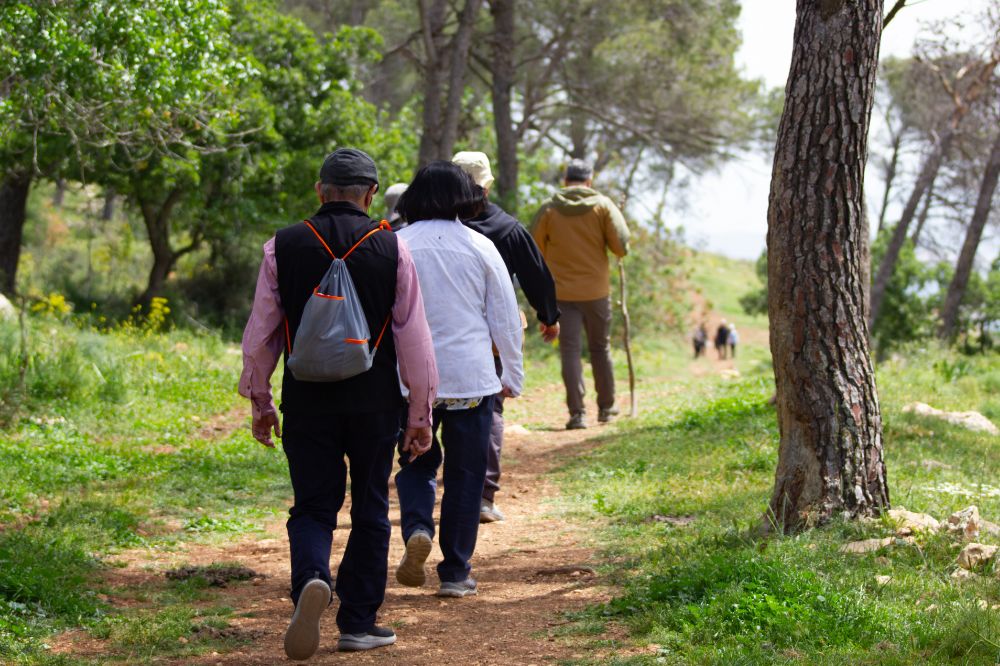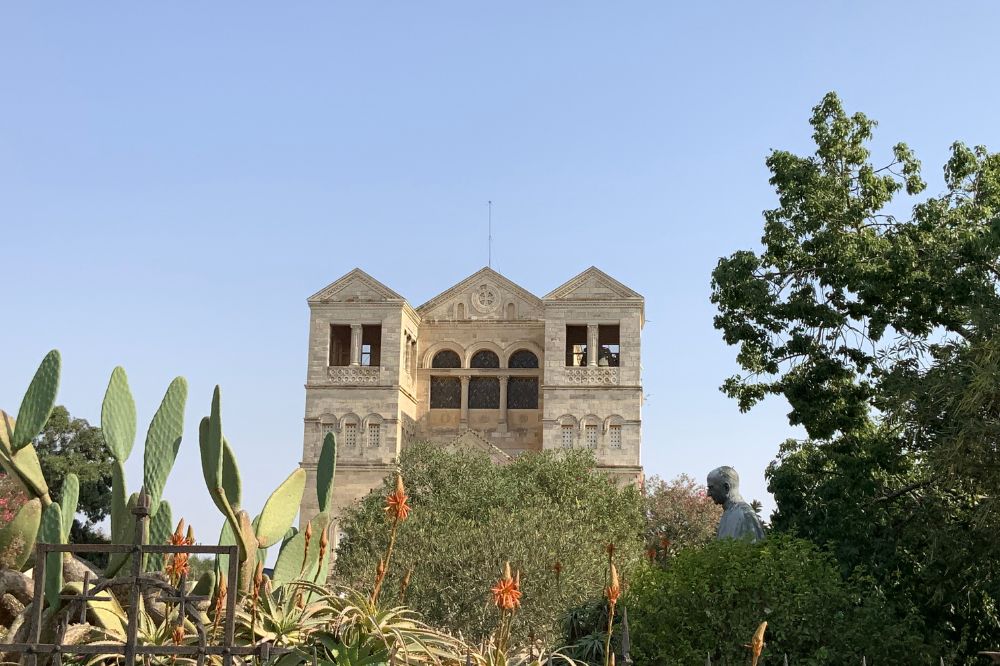
Mount Tabor is a geographical summit and a peak of profound spiritual significance in Christianity.
This place is located in the Galilee region of Israel and has been for timeless ages a beacon of faith, marked by being the site of the Transfiguration of Jesus. According to the gospel accounts, Jesus shone with divine light before Peter, James, and John, revealing His heavenly nature in the presence of Moses and Elijah.
This event strengthened the faith of His disciples and became an eternal symbol of the connection between the Old and New Testaments, representing the fulfillment of the law and the prophets. The purpose of this article is to explore the rich layers of history and spirituality surrounding Mount Tabor, illuminating its relevance both past and present.

Mount Tabor is not just a physical elevation in the Holy Land, but a spiritual peak of immense importance in the Christian narrative. This mountain reveals itself as a fundamental destination for any pilgrimage seeker, representing a place where the divine and the human tangibly meet.
Biblical history and Christian theology have woven around this place a tapestry of faith, prophecy, and revelation. Its threads stretch through the centuries, inviting believers from all over the world to ascend towards the light of spiritual understanding.
In the Gospel of Matthew, the Transfiguration is a moment of profound divine affirmation, where Jesus is transfigured and shines with light before His disciples, symbolizing His divinity. This event not only serves as a foreshadowing of Christ’s resurrection but also strengthens the apostles’ faith in their mission.
Meanwhile, Mark presents the Transfiguration as a turning point in his narrative, highlighting the disciples’ reaction to Jesus’ glory and the voice of God proclaiming, “This is my beloved Son.” This account underscores the importance of recognizing Jesus not only as a teacher and prophet but as the Son of God.
In the Gospel of Luke, the emphasis is on Jesus’ preparation for His departure from this world, placing the Transfiguration in a context of prayer and revelation. The presence of Moses and Elijah discussing Jesus’ future departure from Jerusalem underscores the continuity of God’s salvific plan through both the Old and New Testaments.
The Transfiguration is seen by theologians as an event that reveals Jesus’ divine identity and anticipates the glorious experience that the faithful can expect in eternal life. This episode reaffirms Jesus’ messianic mission and law, situating His teaching within the continuity of the salvific message of the Mosaic law and the prophets.
Over the centuries, it has been venerated as a place of encounter with the divine, incorporating various traditions and testimonies of faith.
The churches and monasteries dotting its summit bear witness to the continuous devotion and the special place Mount Tabor holds in the hearts of believers. It serves as a beacon of hope and a testimony of the divine light that illuminates all those who seek truth and spiritual solace in the Holy Land.

This site is in Lower Galilee. It is a distinct geographical icon, not far from other significant biblical mountains like Mount Carmel and the Mount of Olives.
This solitary mountain, visible from long distances due to its dome-like and isolated shape, rises approximately 575 meters above sea level. It offers panoramic views that include the Jezreel Valley and, on clear days, even Mount Hermon.
The climate is Mediterranean, characterized by hot, dry summers and mild but wet winters. The best time to visit is during spring and autumn when temperatures are more moderate and the landscape is at its peak, facilitating hiking and exploration.
Mount Tabor is accessible both to pilgrims seeking a spiritual journey on foot and to visitors preferring more modern modes of transport.
For pilgrims, there are several trails that wind up to the summit, offering a physically challenging but spiritually rewarding journey. These paths are imbued with a sense of pilgrimage and contemplation, allowing followers to trace the steps of historical and biblical figures.
For those who prefer a more direct access, there are bus and car options from nearby cities, with well-maintained roads leading to the base of the mountain. Additionally, during peak pilgrimage months, special public transportation and organized tours are available to facilitate access for visitors from all over the world.

The pilgrimage to Mount Tabor requires both spiritual and physical preparation, especially for those coming from such sacred and iconic places as Jerusalem. This journey is not only a physical trek through stunning landscapes but also an opportunity for introspection and spiritual growth.
Before embarking on the path to Mount Tabor, it is essential for pilgrims to prepare both physically and spiritually.
As visitors ascend, they may encounter small chapels and monuments inviting pause and reflection, each telling part of the mountain’s history and spiritual significance.
During the pilgrimage, individuals can participate in various activities and rituals that enrich their experience. This includes Masses and prayer services held at the Basilica of the Transfiguration at the summit, where the divine revelation of Jesus is celebrated.
Additionally, many take the opportunity for a renewal baptism or to make confessions as symbols of purification and spiritual renewal.
Testimonials from those who have made this pilgrimage to Mount Tabor often reflect deep personal encounters with the divine, along with a renewed sense of purpose and faith. These accounts vary from experiences of profound peace and clarity to moments of intense spiritual inspiration, all united by the transformative power of having walked on this sacred ground.
These testimonies not only serve as inspiration for future pilgrims but also act as a reminder of the lasting impact a pilgrimage can have on a person’s life.
Mount Tabor is not only a place of profound religious significance but also a site of rich architectural and cultural heritage. Over the centuries, this mountain has inspired the construction of impressive religious structures and has significantly influenced Christian art and culture. It has become a tangible testimony of faith and human creativity.

It is the architectural and spiritual heart of the mountain. Built in the 20th century on the remains of earlier churches, the current basilica was designed by architect Antonio Barluzzi. He is known for his ability to blend modern elements with historical traditions.
This church stands on the site where, according to tradition, the Transfiguration of Jesus occurred, making this place a center of pilgrimage and veneration.
It is notable for its unique architectural design incorporating elements of Byzantine and modern art. Its vivid mosaics depict scenes of the Transfiguration and biblical figures, and its structure allows natural light to spectacularly illuminate the interior, symbolizing divine light. The minor chapels, stone details, and stained glass windows complement the experience.
Mount Tabor houses other religious structures and sites of spiritual significance. These include small chapels and hermitages scattered across the mountain, each with its own history and dedicated to different aspects of Jesus’ life and ministry. These sites offer spaces for personal prayer and contemplation, enriching the pilgrim’s experience.
This place has been the subject of countless works of art: from paintings and sculptures to literature and music. Artists of all ages have found inspiration in the story of the Transfiguration, using its visual and symbolic elements to explore themes of revelation, transformation, and divinity.
This mountain continues to inspire artists and faithful alike, maintaining its relevance and ability to move and motivate those who engage with its history and beauty.
During the Transfiguration, Jesus was shown to His disciples in radiant glory, His face and clothes shining with intense light.
This display of light not only confirmed His divinity to the apostles but also symbolized the light of truth and knowledge that Jesus brought to the world. In Christianity, light is often seen as a metaphor for truth, clarity, and guidance in the darkness of sin and ignorance.
Moreover, the Transfiguration has numerous practical and spiritual applications for Christians today.
Integrating the lessons of the Transfiguration into daily life can start with the development of a deeper, more contemplative prayer life, seeking moments of retreat and reflection to be closer to God.
It also involves bringing the light of Christ to others through acts of kindness, words of truth, and a lifestyle that reflects the values of the Gospel. Christians are called to be the “light of the world,” which means acting as guides and witnesses of God’s hope and love in their daily surroundings.
Aspects for the Traveler
Below are some practical recommendations to ensure your visit is both spiritually and physically rewarding.
In contrast, pilgrimages like those to Jerusalem, where visitors can follow the path of Christ’s Passion through the Via Dolorosa; or Bethlehem, the birthplace of Jesus, offer different perspectives on Jesus’ life and mission. Each site attracts pilgrims for specific reasons: Jerusalem for being the center of crucifixion and resurrection; Bethlehem for its significance in nativity, and Nazareth, where Jesus spent His youth.
Similarly, this place plays a crucial role in the broader pilgrimage routes of the Holy Land. It is geographically close to Nazareth, making it common for pilgrims to combine visits to both places in one trip. Additionally, it can be part of an itinerary that includes the Sea of Galilee, where Jesus performed many of His miracles, and the Jordan River, a baptismal site.
This proximity allows pilgrims to experience a variety of key moments in Jesus’ life within a compact geographical area, enriching their spiritual and contextual experience.
Stay Connected with WayHoly
Discover your perfect pilgrimage and be the first to know about new journeys. By subscribing to our newsletter, you’ll receive the latest updates on pilgrimages, exclusive offers, and spiritual resources to enrich your faith journey.
Don’t miss the opportunity to deepen your connection with God and lead others on their path to spiritual renewal. Join us today and become an instrument of His Will through WayHoly!
“To upload your pilgrimage, please choose one of our plans and create an account, or log in if you’re already a member. Join us in guiding others on their spiritual journey.”